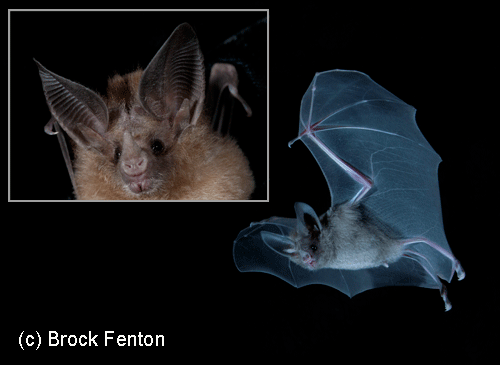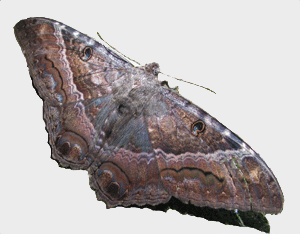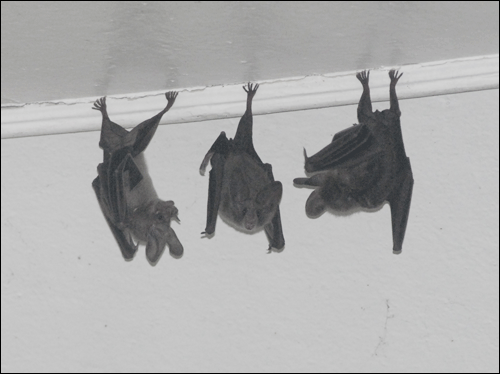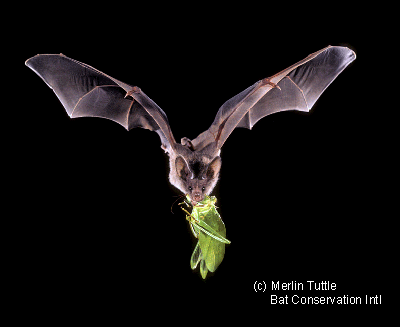Character of the Month:
The Crotchety Old Bachelor of Windsor House
October 2014
 To celebrate Halloween, our inaugural Character of the Month is a BAT (aka “Ratbat” in Jamaica) which goes by the common name Waterhouse’s Big-eared Bat or
by the scientific name Macrotus waterhousii. It was named to pay tribute to the British zoologist G. R. Waterhouse (1810-1888).
To celebrate Halloween, our inaugural Character of the Month is a BAT (aka “Ratbat” in Jamaica) which goes by the common name Waterhouse’s Big-eared Bat or
by the scientific name Macrotus waterhousii. It was named to pay tribute to the British zoologist G. R. Waterhouse (1810-1888).
First, let’s clarify a few confusing things:
Huh???

Back to our Crotchety Old Bachelor
When I moved to Jamaica in 1999, Mr. Mike gave me his old, small office space so he could claim the entire living room for his working area. I was delighted: I quickly discovered that there was a solitary bat living in the ceiling over the office! About 15 minutes before sunset, he would emerge from the closet through an opening in the ceiling, circle my office a few times, and then head outside through an open window. About an hour before sunrise, he would fly through an open window in our bedroom, circle a few times around the room, and then fly back into my office and up into the ceiling, where he would rest throughout the day. I was able to take a photograph of him, which allowed me to confirm his species identity and, at the same time, learn that “he” was, indeed, a “he".
For more than 12 years, this male Macrotus lived year-round in my . . . correction . . . his office ceiling. He generally kept to himself, minded his own business, occasionally left the wings of moths he’d eaten littering the floor in the hallway. During the hottest months of summer (esp. August), he’d make audible chattering, spitting noises to himself mid-afternoon . . . then fly out from his office ceiling . . .then hang in the corridor for a bit . . . then fly back to his office ceiling . . .then mutter again . . .and do the flight circuit again. Given that the roof temperature easily exceeds 45 degrees C in the summer, I don’t fault him for grumbling.
 Or perhaps he was just talking to himself, reliving the memories of his mis-spent summer months: around the middle- to end of May, for about 2-3 weeks,
over several years, he was joined by 1-2 new Macrotus bats during the night. I never made any attempts to catch them during these periods,
to determine whether the new bats were females (woo hoo!) or, perhaps young, inexperienced males who were coming to learn “feeding tips” from an old, experienced,
wizened bachelor. Whatever was happening, I didn’t want to trouble them by catching them. Afterall, they never directly troubled me, so why should I be rude and trouble them?
And by July, the vistors always left and our old guy just continued to potter around by himself for the rest of the year.
Or perhaps he was just talking to himself, reliving the memories of his mis-spent summer months: around the middle- to end of May, for about 2-3 weeks,
over several years, he was joined by 1-2 new Macrotus bats during the night. I never made any attempts to catch them during these periods,
to determine whether the new bats were females (woo hoo!) or, perhaps young, inexperienced males who were coming to learn “feeding tips” from an old, experienced,
wizened bachelor. Whatever was happening, I didn’t want to trouble them by catching them. Afterall, they never directly troubled me, so why should I be rude and trouble them?
And by July, the vistors always left and our old guy just continued to potter around by himself for the rest of the year.
In his later years, our old Macrotus developed an auto-immune condition called vitiligo – this is where the pigment disappears from the skin and white patches form. It’s what Michael Jackson said he had and it’s not uncommon in Macrotus waterhousii. It affected our guy’s flight, to the extent that he sounded “heavier” in flight compared to other Macrotus and for several years, when he made his pre-dawn circuit through the bedroom, we always knew “there’s our old Macrotus, still hanging in there”.

Sadly, in early 2012, we realized we weren’t hearing him in the pre-dawn hours anymore. I hadn’t been using my office for about a year (that’s another story...), so I hadn’t noticed he wasn’t coming out of the closet at sunset. Given that he was in the ceilng before I moved to Jamaica, his lifespan exceeded 12 years – pretty darn good for an animal that weighs about 20 grams (that’s about the same weight at J$ 45 jingling in your pocket (two 20 dollar coins + one 5 dollar coin) or US₵ 76 (3 quarters + 1 penny).
 Of course, he was invaluable for the ecosystem service of pest control he contributed – in his own little way, our old Macrotus ate countless
grasshoppers and katydids – insects that can cause damage to the leaves of sugarcane. With his big ears, Macrotus could have found insects
by listening for the audible noises the grasshoppers made as they rustled through the vegetation. He probably also used his ultrasonic echolocation calls to create a 3-D "acoustic
image" of animals sleeping on leaves - and grab a snack on-the-wing.
He certainly used his ultrasonic
echolocation (with food in his mouth!) to navigate through the understory
and find his way back home.
Of course, he was invaluable for the ecosystem service of pest control he contributed – in his own little way, our old Macrotus ate countless
grasshoppers and katydids – insects that can cause damage to the leaves of sugarcane. With his big ears, Macrotus could have found insects
by listening for the audible noises the grasshoppers made as they rustled through the vegetation. He probably also used his ultrasonic echolocation calls to create a 3-D "acoustic
image" of animals sleeping on leaves - and grab a snack on-the-wing.
He certainly used his ultrasonic
echolocation (with food in his mouth!) to navigate through the understory
and find his way back home.
So when you drink your next glass of sugarcane-derived Jamaican Rum, drink a toast to a Big-eared ‘Ratbat’.
Post Script
On January 1st 2014, having been back working in my office for about a month, I saw a new Macrotus waterhousii leave the closet.
He or she has been in continuous residence ever since, living the singles lifestyle, just like our old guy. Kind of neat to think that it could be a son or daughter
and that Windsor House continues to offer a safe haven. That’s worth another rum punch.
Post Post Script
My grasshopper friend Daniel has corrected me: grasshoppers and katydids don't damage sugarcane leaves. Although they can be abundant, noticeably along the edges of the fields,
and they "bug" me because they dominate acoustic recordings I make of bats which are feeding in the airspace above the sugarcane, they are innocent.
To extend my apologies to all orthoptera in the Caribbean, we're going to let the crickets sing a love song on Valentine's Day.
Stay tuned for February 2015's Character.
You can still enjoy your rum punch: cheers!
| NEXT CHARACTER |

